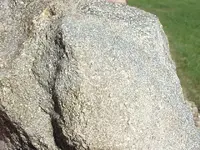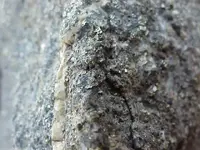Already identified as graphite schist, so metamorphically altered coal at low temperature. Graphite (carbon) appears to be a major component of the rock, or it wouldn't leave your hands that color.
So the question now remains: what is setting the rock off for the detector. A detector would not detect graphite as a metal. Nor would it identify mica or pyrite as metal.
Kuger states it is not gold. I am not so certain.
Mica in my experience usually appears and flat plate-like granules. In larger plates, it used to be called isinglass, and was once used as window panes for early windows. It does distort an image. Want to see what it looks like? Check out Clint Eastwood's motion picture "High Plains Drifter" and look at the windows: isinglass, aka mica.
Iron pyrite is fool's gold, but is also a combination of iron and sulphur. Yet there is no smell of sulphur after the rock has been struck with a hammer (steel, right?). Iron pyrite plus steel is a good way of striking sparks. Iron pyrite and flint is another way.
The only iron pyrite I have seen personally have been in mostly larger crystals, not in what appear to be small globules embedded within the graphite.
So in my opinion, I don't know. Globules do not appear pyrite-like to my eye. Lack of sulphur odor after hammer strikes also supports sulphur-poor content.
It looks to me as if this rock has a layered sedimentary look. Coal could be sedimentary, especially in low-grade condition. Most coal has at least some sulphur content as well, which makes it typically unsuitable for energy production, as burning it produces sulphuric dioxide, which combines with water in the atmosphere to produce sulphuric acid. The human nose is sentive to sulphur and sulphuric dioxide (rotten egg smell).
I'd like to see some of the material ground up and panned. If the globular material is much heavier than the graphic, you should end up with a flour-type residue in the bottom of a gold pan. Add a few lead shot to the gold pan, and continue panning until only the lead shot are still in the pan. If you still have a golden residue or flakes in the bottom of the pan, it probably is gold. Iron pyrite would be much lighter than lead (or steel) shot pellets.
High Plains Digger wonders what else is necessary for gunpowder. I believe it may be potash. I don't want to say more for fear of having someone trying to create their own gunpowder, but potash is VERY common.
Geologists has already identified this as graphite schist. I think that deserves a solved icon.














